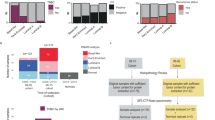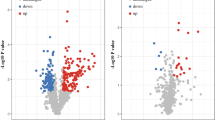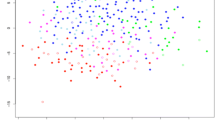Abstract
Normal mammary gland homeostasis requires the coordinated regulation of protein signaling networks. However, we have little prospective information on whether activation of protein signaling occurs in premalignant mammary epithelial cells, as represented by cells with cytological atypia from women who are at high risk for breast cancer. This information is critical for understanding the role of deregulated signaling pathways in the initiation of breast cancer and for developing targeted prevention and/or treatment strategies for breast cancer in the future. In this pilot and feasibility study, we examined the expression of 52 phosphorylated, total, and cleaved proteins in 31 microdissected Random Periareolar Fine Needle Aspiration (RPFNA) samples by high-throughput Reverse Phase Protein Microarray. Unsupervised hierarchical clustering analysis indicated the presence of four clusters of proteins that represent the following signaling pathways: (1) receptor tyrosine kinase/Akt/mammalian target of rapamycin (RTK/Akt/mTOR), (2) RTK/Akt/extracellular signal-regulated kinase (RTK/Akt/ERK), (3) mitochondrial apoptosis, and (4) indeterminate. Clusters 1 through 3 comprised moderately to highly expressed proteins, while Cluster 4 comprised proteins that are lowly expressed in a majority of RPFNA samples. Our exploratory study showed that the interlinked components of mitochondrial apoptosis pathway are highly expressed in all mammary epithelial cells obtained from high-risk women. In particular, the expression levels of anti-apoptotic Bcl-xL and pro-apoptotic Bad are positively correlated in both non-atypical and atypical samples (unadjusted P < 0.0001), suggesting a delicate balance between the pro-apoptotic and anti-apoptotic regulation of cell proliferation during the early steps of mammary carcinogenesis. Our feasibility study suggests that the activation of key proteins along the RTK/Akt pathway may tip this balance to cell survival. Taken together, our results demonstrate the feasibility of mapping proteomic signaling networks in limited RPFNA samples obtained from high-risk women and the promise of developing rational drug targets or preventative strategies for breast cancer in future proteomic studies with a larger cohort of high-risk women.





Similar content being viewed by others
Notes
Original pathway map was obtained from SABiosciences Pathway Central (www.sabiosciences.com).
Abbreviations
- Apaf-1:
-
Apoptotic protease activating factor-1
- Bad:
-
Bcl2-antagonist of cell death
- Bax:
-
Bcl2 associated X-protein
- Bcl-2:
-
B-cell lymphoma-2
- Bid:
-
Bcl2 interacting protein
- BRCA1/2:
-
Breast cancer-associated gene 1/2
- CK2:
-
Casein kinase II or 2
- DCIS:
-
Ductal carcinoma in situ
- EGFR:
-
Epidermal growth factor receptor
- ER:
-
Estrogen receptor
- ErbB:
-
Erythroblastic leukemia viral oncogene homolog
- ERK:
-
Extracellular signal-regulated kinase
- FADD:
-
Fas-associated via death domain
- IHC:
-
Immunohistochemistry
- IGF-1R:
-
Insulin-like growth factor receptor
- LCIS:
-
Lobular carcinoma in situ
- LCM:
-
Laser capture microdissection
- mTOR:
-
Mammalian target of rapamycin
- OR:
-
Operating room
- PI3K:
-
Phosphatidylinositol 3-kinase
- PTEN:
-
Phosphatase and tensin homolog
- RPFNA:
-
Random Periareolar Fine Needle Aspiration
- RPPM:
-
Reverse phase protein microarray
- RTK:
-
Receptor tyrosine kinase
References
Wickenden JA, Watson CJ (2010) Signalling downstream of PI3 kinase in mammary epithelium: a play in 3 Akts. Breast Cancer Res 12:202
Hynes NE, Watson CJ (2010) Mammary gland growth factors: roles in normal development and in cancer. Cold Spring Harb Perspect 2:a003186
Brandt R, Eisenbrandt R, Leenders F, Zschiesche W, Binas B, Juergensen C, Theuring F (2000) Mammary gland specific hEGF receptor transgene expression induces neoplasia and inhibits differentiation. Oncogene 19:2129–2137
Wood TL, Richert MM, Stull MA, Allar MA (2000) The insulin-like growth factors (IGFs) and IGF binding proteins in postnatal development of murine mammary glands. J Mammary Gland Biol Neoplasia 5:31–42
Arboleda MJ, Lyons JF, Kabbinavar FF, Bray MR, Snow BE, Ayala R, Danino M, Karlan BY, Slamon DJ (2003) Overexpression of Akt2/protein kinase Bβ leads to up-regulation of β1 integrins, increased invasion, and metastasis of human breast and ovarian cancer cells. Cancer Res 63:196–206
Hutchinson JN, Jin J, Cardiff RD, Woodgett JR, Muller WJ (2004) Activation of Akt-1 (PKB-alpha) can accelerate ErbB-2-mediated mammary tumorigenesis but suppresses tumor invasion. Cancer Res 64:3171–3178
Nakatani K, Thompson DA, Barthel A, Sakaue H, Liu W, Weigel RJ, Roth RA (1999) Up-regulation of Akt3 in estrogen receptor-deficient breast cancers and androgen-independent prostate cancer lines. J Biol Chem 274:21528–21532
Gulmann C, Sheehan KM, Kay EW, Liotta LA, Petricoin EF III (2006) Array-based proteomics: mapping of protein circuitries for diagnostics, prognostics, and therapy guidance in cancer. J Pathol 208:595–606
Petricoin EF III, Bichsel VE, Calvert VS, Espina V, Winters M, Young L, Belluco C, Trock BJ, Lippman M, Fishman DA, Sgroi DC, Munson PJ, Esserman LJ, Liotta LA (2005) Mapping molecular networks using proteomics: a vision for patient-tailored combination therapy. J Clin Oncol 23:3614–3621
Hait WN (2009) Targeted cancer therapeutics. Cancer Res 69:1263–1267
Espina V, Liotta LA, Petricoin EF III (2009) Reverse-phase protein microarrays for theranostics and patient tailored therapy. Methods Mol Biol 520:89–105
Paweletz CP, Charboneau L, Bichsel VE, Simone NL, Chen T, Gillespie JW, Emmert-Buck MR, Roth MJ, Petricoin EF III, Liotta LA (2001) Reverse phase protein microarrays which capture disease progression show activation of pro-survival pathways at the cancer invasion front. Oncogene 20:1981–1989
Petricoin EF III, Espina V, Araujo RP, Midure B, Yeung C, Wan X, Eichler GS, Johann DJ Jr, Qualman S, Tsokos M, Krishnan K, Helman LJ, Liotta LA (2007) Phosphoprotein pathway mapping: Akt/mammalian target of rapamycin activation is negatively associated with childhood rhabdomyosarcoma survival. Cancer Res 67:3431–3440
Fabian CJ, Kimler BF, Zalles CM, Klemp JR, Kamel S, Zeiger S, Mayo MS (2000) Short-term breast cancer prediction by random periareolar fine-needle aspiration cytology and the Gail risk model. J Natl Cancer Inst 92:1217–1227
Fabian CJ, Kimler BF, Brady DA, Mayo MS, Chang CH, Ferraro JA, Zalles CM, Stanton AL, Masood S, Grizzle WE, Boyd NF, Arneson DW, Johnson KA (2002) A phase II breast cancer chemoprevention trial of oral alpha-difluoromethylornithine: breast tissue, imaging, and serum and urine biomarkers. Clin Cancer Res 8:3105–3117
Ibarra-Drendall C, Wilke LG, Zalles C, Scott V, Archer LE, Lem S, Yee LD, Lester J, Kulkarni S, Murekeyisoni C, Wood M, Wilson K, Garber J, Gentry C, Stouder A, Broadwater G, Baker JC Jr, Vasilatos SN, Owens E, Rabiner S, Barron AC, Seewaldt VL (2009) Reproducibility of random periareolar fine needle aspiration in a multi-institutional Cancer and Leukemia Group B (CALGB) cross-sectional study. Cancer Epidemiol Biomarkers Prev 18:1379–1385
Bean GR, Scott V, Yee L, Ratliff-Daniel B, Troch MM, Seo P, Bowie ML, Marcom PK, Slade J, Kimler BF, Fabian CJ, Zalles CM, Broadwater G, Baker JC Jr, Wilke LG, Seewaldt VL (2005) Retinoic acid receptor-beta2 promoter methylation in random periareolar fine needle aspiration. Cancer Epidemiol Biomarkers Prev 14:790–798
Bean GR, Ibarra Drendall C, Goldenberg VK, Baker JC Jr, Troch MM, Paisie C, Wilke LG, Yee L, Marcom PK, Kimler BF, Fabian CJ, Zalles CM, Broadwater G, Scott V, Seewaldt VL (2007) Hypermethylation of the breast cancer-associated gene 1 promoter does not predict cytologic atypia or correlate with surrogate end points of breast cancer risk. Cancer Epidemiol Biomarkers Prev 16:50–56
Zalles C, Kimler BF, Kamel S, McKittrick R, Fabian CJ (1995) Cytology patterns in random aspirates from women at high and low risk for breast cancer. Breast J 1:343–349
Masood S, Frykberg ER, McLellan GL, Scalapino MC, Mitchum DG, Bullard JB (1990) Prospective evaluation of radiologically directed fine-needle aspiration biopsy of nonpalpable breast lesions. Cancer 66:1480–1487
Barry WT, Nobel AB, Wright FA (2008) A statistical framework for testing functional categories in microarray data. Ann Appl Stat 2:286–315
Skolnick MH, Cannon-Albright LA, Goldgar DE, Ward JH, Marshall CJ, Schumann GB, Hogle H, McWhorter WP, Wright EC, Tran TD et al (1990) Inheritance of proliferative breast disease in breast cancer kindreds. Science 250:1715–1720
Wrensch MR, Petrakis NL, Miike R, King EB, Chew K, Neuhaus J, Lee MM, Rhys M (2001) Breast cancer risk in women with abnormal cytology in nipple aspirates of breast fluid. J Natl Cancer Inst 93:1791–1798
Page DL, Dupont WD (1990) Anatomic markers of human premalignancy and risk of breast cancer. Cancer 66:1326–1335
Marshall LM, Hunter DJ, Connolly JL, Schnitt SJ, Byrne C, London SJ, Colditz GA (1997) Risk of breast cancer associated with atypical hyperplasia of lobular and ductual types. Cancer Epidemiol Biomarkers Prev 6:297–301
Hengartner MO (2000) The biochemistry of apoptosis. Nature 407:770–776
Youle RJ, Strasser A (2008) The BCL-2 protein family: opposing activities that mediate cell death. Nat Rev Mol Cell Biol 9:47–59
Hanahan D, Weinberg RA (2000) The hallmarks of cancer. Cell 100:57–70
Harris SL, Levine AJ (2005) The p53 pathway: positive and negative feedback loops. Oncogene 24:2899–2908
Pilie PG, Ibarra-Drendall C, Troch MM, Broadwater G, Barry WT, Petricoin EF III, Wulfkuhle JD, Liotta LA, Lem S, Baker JC Jr, Stouder A, Ford AC, Wilke LG, Zalles CM, Mehta P, Williams J, Shivraj M, Su Z, Geradts J, Yu D, Seewaldt VL (2011) Protein microarray analysis of mammary epithelial cells from obese and nonobese women at high risk for breast cancer: feasibility data. Cancer Epidemiol Biomarkers Prev 20:476–482
Foley J, Nickerson NK, Nam S et al (2010) EGFR signaling in breast cancer: bad to the bone. Semin Cell Dev Biol 21:951–960
Khwaja A, Rodriguez-Viciana P, Wennstrom S, Warne PH, Downward J (1997) Matrix adhesion and Ras transformation both activate a phosphoinositide 3-OH kinase and protein kinase B/Akt cellular survival pathway. EMBO J 16:2783–2793
Datta SR, Dudek H, Tao X, Masters S, Fu H, Gotoh Y, Greenberg ME (1997) Akt phosphorylation of BAD couples survival signals to the cell-intrinsic death machinery. Cell 91:231–241
Zha J, Harada H, Yang E, Jockel J, Korsmeyer SJ (1996) Serine phosphorylation of death agonist BAD in response to survival factor results in binding to 14-3-3 not BCL-X(L). Cell 87:619–628
Zha J, Harada H, Osipov K, Jockel J, Waksman G, Korsmeyer SJ (1997) BH3 domain of BAD is required for heterodimerization with BCL-XL and pro-apoptotic activity. J Biol Chem 272:24101–24104
Torres J, Pulido R (2001) The tumor suppressor PTEN is phosphorylated by protein kinase CK2 at its C terminus. Implications for PTEN stability to proteasome-mediated degradation. J Biol Chem 276:993–998
Vazquez F, Grossman SR, Takahashi Y, Rokas MV, Nakamura N, Sellers WR (2001) Phosphorylation of the PTEN tail acts as an inhibitory switch by preventing its recruitment into a protein complex. J Biol Chem 276:48627–48630
Rapkiewicz A, Espina V, Zujewski Ja, Lebowitz PF, Filie A, Wulfkuhle J, Camphausen K, Petricoin EF III, Liotta LA, Abati A (2007) The needle in the haystack: application of breast fine-needle aspirate samples to quantitative protein microarray technology. Cancer 111:173–184
Ahmad KA, Wang G, Unger G, Slaton J, Ahmed K (2008) Protein kinase CK2—a key suppressor of apoptosis. Adv Enzymol Regul 48:179–187
Acknowledgments
The authors thank Susan G. Komen for the Cure foundation for financial support to Drs. Yu and Seewaldt (KG091020) and Dr. Ibarra-Drendall (KG090730). Dr. Seewaldt is also supported by the National Institute of Health/National Cancer Institute (R01CA88799 and R01CA114068). Additional financial support was provided by NCI/AVON Partners in Progress Grant 3 P30 CA014236-32S1 to Drs. Seewaldt and Yu.
Author information
Authors and Affiliations
Corresponding author
Rights and permissions
About this article
Cite this article
Ibarra-Drendall, C., Troch, M.M., Barry, W.T. et al. Pilot and feasibility study: prospective proteomic profiling of mammary epithelial cells from high-risk women provides evidence of activation of pro-survival pathways. Breast Cancer Res Treat 132, 487–498 (2012). https://doi.org/10.1007/s10549-011-1609-9
Received:
Accepted:
Published:
Issue Date:
DOI: https://doi.org/10.1007/s10549-011-1609-9




